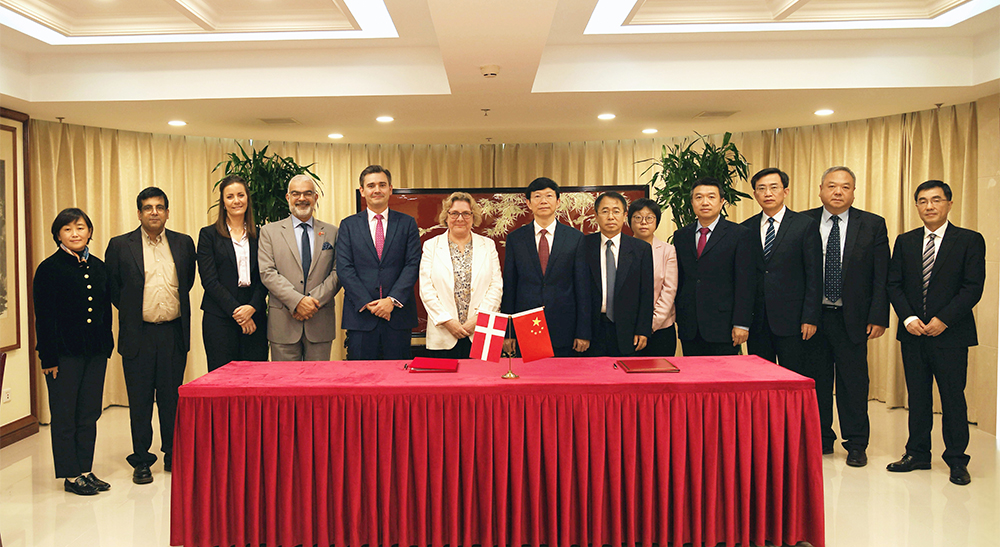好文推荐 | 线粒体自噬对缺血性脑卒中的作用及其机制研究进展
时间:2024-03-16 20:01:28 热度:37.1℃ 作者:网络
摘要
线粒体自噬作为一种选择性自噬,是线粒体质量控制的关键机制之一。脑组织缺血可引发多种分子的级联反应,导致功能障碍线粒体的堆积。线粒体功能障碍可诱导线粒体自噬的激活,通过清除受损或去极化线粒体来维持神经元细胞的稳态。研究表明线粒体自噬与缺血性脑卒中的病理过程密切相关,但其具体机制及其作用一直备受争议。本文就线粒体自噬的发生机制及其在缺血脑组织中的作用进行综述,为临床治疗缺血性脑卒中提供新的思路。
脑卒中是一种常见的急危脑血管疾病,在美国心脏协会2019年发布的死亡原因中排名第五,这种疾病已经成为残疾和死亡的主要原因之一。脑卒中类型包括缺血性脑卒中和出血性脑卒中,其中缺血性脑卒中是最常见的脑卒中类型,约占总数的70%~80%。目前,恢复脑血流灌注、挽救缺血半暗带仍是治疗缺血性脑卒中唯一有效的方法,主要包括组织纤溶酶原激活剂(tissue plasminogen activator,tPA)静脉溶栓和血管内机械取栓。缺血性脑卒中的发病机制尤为复杂,主要与兴奋性毒性、线粒体功能障碍、氧化应激、炎症反应、细胞凋亡等病理过程密切相关。近期研究表明,线粒体功能障碍是导致缺血脑组织神经细胞损伤的重要病理基础。同时研究发现,改善线粒体的功能有助于缺血神经元的存活和神经功能的维持。
线粒体是一种存在于大多数细胞中的双膜细胞器,它在细胞的能量产生、钙平衡调节、程序性死亡调控、细胞增殖与代谢等方面发挥着重要作用。然而,线粒体也会产生可能损害细胞的有害物质,如磷酸化的有毒副产物活性氧(reactive oxygen species,ROS),ROS包括超氧阴离子、过氧化氢和羟基自由基等,进一步激活相关的炎症小体,加速促炎细胞因子的释放。同时线粒体损伤后会向细胞膜释放高水平的Ca2+和细胞色素C(cytochrome C,Cyt C),从而引发细胞凋亡。因此,线粒体损伤是缺血后神经元细胞死亡的原因之一。线粒体自噬是专门针对受损线粒体的一种选择性自噬,这种反应不仅可以清除受损的线粒体,而且还可以防止缺血神经元中的线粒体依赖性细胞凋亡。因此,有研究者提出增强线粒体自噬可以作为保护缺血神经元的一种新型治疗策略。本文就线粒体自噬的发生机制及其在缺血脑组织中的作用进行综述,以期为缺血性脑卒中的治疗提供新的思路。
1 自噬及线粒体自噬的概述
自噬(autophagy)是受损的蛋白质或细胞器被自噬囊泡包裹,再与溶酶体融合形成自噬溶酶体,从而降解其内容物并循环利用的调节过程,最终维持细胞内环境的稳定。在哺乳动物细胞中,有3种主要类型的自噬:巨自噬(macroautophagy)、微自噬(microautophagy)和分子伴侣介导的自噬(chaperone mediated autophagy,CMA)。其中,巨自噬是自噬的主要类型,根据其降解底物有无特异性可分为两种:一种是非选择性自噬,主要在饥饿状态下为细胞提供营养,以维持细胞最基本的能量物质代谢;另一种为选择性自噬(底物特异性自噬),主要是清除部分受损细胞器或细胞结构,防止其对细胞产生进一步损伤,在维持体内平衡方面至关重要。在生理状态时,细胞中的自噬通常保持在基础水平以维持体内平衡;当超出自我修复的范围时,自噬会被诱导激活,腺苷酸单磷酸活化蛋白酶(AMP-activated protein kinase,AMPK)能够感受能量水平的降低,通过抑制哺乳动物雷帕霉素靶蛋白(mammalian target of rapamycin,mTOR)或磷酸化UNC-51样激酶1(unc-51-like kinase 1,ULK1)来激活自噬。
线粒体自噬是专门针对受损线粒体的一种巨自噬反应,这也是目前已知的唯一一种可以选择性地清除功能障碍线粒体的途径。同时,线粒体自噬是保护线粒体质量和功能、调控细胞命运的关键过程。许多研究表明,线粒体自噬缺陷在不同疾病中发挥作用,如阿尔茨海默病、帕金森病及亨廷顿病等。目前,线粒体自噬的调控机制主要有两类:泛素依赖型途径和受体依赖型途径。泛素依赖型途径主要包括PTEN诱导的推定激酶蛋白1-E3泛素连接酶(PINK1-Parkin)信号通路,这是目前线粒体自噬调控机制中研究最广泛的通路;而受体依赖型是由线粒体自噬受体蛋白介导,包括Bcl-2/腺病毒E1B 19 kDa相互作用蛋白3(BCL2-interacting protein 3,BNIP3)、Nip3样蛋白X(NIP3-like protein X,NIX)和含FUN14结构域蛋白-1(FUN14 domain-containing protein-1,FUNDC1)等。
2 脑缺血缺氧诱导线粒体自噬的激活
线粒体自噬的主要通路是PINK1-Parkin信号通路。PINK1是一种丝氨酸/苏氨酸蛋白激酶,存在于线粒体外膜上。在生理状态时,线粒体中PINK1被基质加工肽酶(mitochondrial processing peptidase,MPP)和早老素菱形蛋白(presenilin-associated rhomboid-like protease,PARL)等蛋白酶快速降解,因此在线粒体中PINK1的含量较低。而当脑组织缺血缺氧时,线粒体功能发生障碍,ROS释放增加及ATP产生减少,同时MPP及PARL等蛋白酶的活性也会受到抑制,这使得线粒体外膜上的PINK1逐渐积累,并诱导E3泛素连接酶Parkin的募集,进而加速线粒体外膜蛋白的泛素化,最终促进线粒体自噬的激活。
线粒体自噬受体蛋白BNIP3/NIX和FUNDC1在缺血缺氧诱导的线粒体自噬过程中也发挥重要的作用。Liu等研究发现,BNIP3/NIX是缺氧诱导因子-1α(hypoxia-inducible factor-1α,HIF-1α)的靶基因,在脑组织缺血缺氧时,HIF-1α被激活并进入细胞核内与BNIP3/NIX中的缺氧反应元件结合,进而促进BNIP3/NIX蛋白的高表达,最终直接与微管相关蛋白1的轻链3(microtubule-associated-proteinlight-chain-3,LC3)结合介导线粒体自噬的激活。同样,Wu等研究发现,BNIP3/NIX被蛋白酶体降解后会引起缺血神经元中线粒体自噬的缺陷。在常氧条件下,FUNDC1在线粒体外膜上高度保守且稳定,其Ser13和Tyr18分别被酪蛋白激酶2(casein kinase-2,CK2)和Src磷酸化,从而抑制FUNDC1与LC3的结合,进而减弱线粒体自噬;然而,在脑组织缺血缺氧时,线粒体磷酸甘油酸变位酶会促进FUNDC1的去磷酸化,导致CK2和Src脱离FUNDC1,从而增强FUNDC1与LC3的相互作用,进而促进线粒体自噬。
3 线粒体自噬在缺血性脑卒中的分子作用机制
3.1 线粒体自噬与炎症反应
炎症反应是缺血后脑组织损伤的主要原因之一,其中NLRP3炎症小体在其炎症反应中发挥至关重要的作用。NLRP3炎症小体是细胞质中多蛋白复合体,缺血脑组织线粒体功能障碍会导致线粒体ROS(mitochondrial ROS,mtROS)产生与线粒体DNA(mitochondrial DNA,mtDNA)释放,从而激活NLRP3炎症小体,然后募集并激活ASC(apoptoticspot-like protein,ASC),促进Pro-Caspase-1的成熟,最终激活下游的促炎细胞因子,加剧缺血脑组织的损伤。线粒体自噬的诱导通过促进细胞内功能障碍线粒体的选择性清除调控NLRP3炎症小体的活性,抑制小胶质细胞释放促炎因子,从而减轻缺血性脑卒中后神经细胞的炎症反应。越来越多的证据表明,线粒体自噬相关调节因子(PINK1/Parkin、P62/SQSTM1)缺陷可通过提高NLRP3炎症小体的活性增加IL-1β、IL-18依赖的炎症反应。Qi等在大脑中动脉闭塞(MCAO)模型中发现,利用转录因子ATF4(activating transcription factor,ATF4)显著上调Parkin蛋白的表达,增加线粒体自噬的活性,同时NLRP3炎症小体、IL-1β、IL-18等炎症因子明显减少,该结果表明线粒体自噬可以减轻脑缺血缺氧介导的神经炎症反应。该研究进一步用SiRNA敲除Parkin蛋白,发现线粒体自噬的作用减弱且NLRP3炎症小体的作用增强,同时促进脑缺血组织神经元的炎症反应,最终加重脑组织损伤。此研究证实了线粒体自噬活性同炎症反应的强度存在负相关,也证实了PINK1-Parkin信号通路是线粒体自噬的重要通路。由上述可知,激活线粒体自噬可减轻缺血性脑卒中的炎症反应,从而改善缺血脑组织中的神经元损伤,这可能是未来治疗缺血性脑卒中的新靶点。
3.2 线粒体自噬与细胞凋亡
细胞凋亡是一种程序性细胞死亡过程,在各种生物事件中扮演着重要的作用。在细胞凋亡的信号通路中,线粒体凋亡通路是触发细胞凋亡最重要的信号通路之一,其由B细胞淋巴瘤2(B cell lymphoma/leukemia 2 gene,Bcl-2)家族中的促凋亡和抗凋亡成员介导。在细胞凋亡过程中,Bcl-2家族蛋白调节线粒体外膜通透性,细胞色素C和其他促凋亡分子从线粒体释放到细胞质中,并与凋亡蛋白水解酶激活因子-1(apoptotic protease activating factor-1,Apaf-1)结合,形成一个复合体激活Caspase-9,继而激活Caspase-3,最终促进细胞的凋亡。脑缺血可引起神经细胞的线粒体功能障碍,同时激活线粒体凋亡信号通路。因此,及时清除功能障碍线粒体可以减轻脑缺血诱导的细胞凋亡,对脑组织缺血部位神经元功能的恢复至关重要。Li等研究发现,二苯乙烯苷通过促进线粒体自噬,抑制神经细胞凋亡来改善氧糖剥夺/复氧(oxygen-glucose deprivation/reperfusion,OGD/R)损伤,其具体机制可能是通过上调细胞中线粒体去乙酰化蛋白(sirtuin-3,SIRT3)和AMPK蛋白的表达,SIRT3脱乙酰化后可以激活下游的AMPK信号通路,促进线粒体自噬相关蛋白PINK1及Parkin的表达,同时细胞凋亡相关因子Caspase-3和Bax的表达随之下降。因此,本研究表明,促进线粒体自噬的激活会抑制缺血脑组织神经元细胞的凋亡。林筱洁等在体外缺血模型中发现,黄芩苷能够剂量依赖性地促进线粒体自噬受体蛋白FUNDC1的mRNA表达,减少缺氧后的凋亡及坏死细胞数量,从而减轻缺血脑组织的神经元细胞的凋亡。综上所述,线粒体自噬在缺血损伤中发挥重要的保护作用,具有抑制缺血脑组织神经元细胞凋亡并改善神经功能的作用。
3.3 线粒体自噬与氧化应激
当脑组织的氧糖供应骤然减少或中断时,会导致ROS水平迅速升高。由于脑组织的抗氧化酶水平较低,因此在短时间内出现严重的氧化应激损伤。生理状态下,细胞内ROS保持在恒定的低水平,而持续高水平的ROS会破坏细胞内的生物大分子,包括核酸(DNA/RNA)、蛋白质和脂类,最终导致细胞功能障碍。研究表明,缺血损伤产生的mtROS通过各种信号通路诱导线粒体自噬的激活,而线粒体自噬也可以通过多种途径减轻脑缺血中的氧化应激损伤。Di等在短暂性大脑中动脉闭塞(transient middle cerebral artery occlusion,tMCAO)模型小鼠的研究中发现,亚加蓝能够显著增加线粒体自噬的分子标志物Beclin-1及LC3,同时皮质神经元中出现线粒体自噬的典型形态特征,其通过增加线粒体自噬的诱导,降低ROS的产生来减缓脑梗死的体积并改善神经功能。有趣的是,使用自噬抑制剂3-甲基腺嘌呤(3-methyladenosine,3-MA)抑制线粒体自噬时,亚加蓝对ROS水平的抑制也被破坏。同样,在海马神经元OGD/R模型中,细胞ROS水平及细胞凋亡显著增加,予以雷帕霉素(一种自噬激活剂)后能够促进LC3、PINK1及Parkin蛋白表达,并显著抑制细胞内ROS水平及细胞凋亡的升高。而予以自噬抑制剂时效果相反,缺血组织神经细胞损伤加重。综上所述,促进线粒体自噬可以降低ROS水平的升高,减少神经元的氧化应激损伤,同时利于缩小脑梗死的体积并改善患者的神经功能。
3.4 线粒体自噬与坏死性凋亡
坏死性凋亡是一种经典的程序性细胞死亡,主要通过受体相互作用蛋白激酶1(receptor interacting protein kinase-1,RIPK1)、受体相互作用蛋白激酶3(receptor interacting protein kinase-3,RIPK3)和混合谱系激酶结构域样蛋白(mix lineage kinase domain-like protein,MLKL)调节。在脑缺血性损伤时,RIPK1及其下游分子RIPK3被磷酸化,促使MLKL被激活并转位至细胞膜,改变细胞通透性并释放胞质内容物,最终导致细胞坏死性凋亡。PGAM5是一种丝氨酸/苏氨酸蛋白磷酸酶,其在坏死性凋亡的机制中发挥至关重要的作用。线粒体自噬和细胞坏死性凋亡之间存在着密切的联系。最新研究报道,PGAM5通过促进线粒体自噬以补偿轻微受损线粒体的不利刺激,从而发挥细胞保护作用。而在严重受损线粒体中,PGAM5介导的线粒体过度分裂最终导致坏死性凋亡的形成。其中研究最广泛的是线粒体自噬受体蛋白FUNDC1,在生理条件下,FUNDC1在线粒体外膜上高度保守且稳定,其Ser13和Tyr18分别被酪蛋白激酶2(CK2)和酪氨酸专一性蛋白激酶(Src激酶)磷酸化,从而影响其与LC3的结合并抑制线粒体自噬。然而,在病理条件下,磷酸甘油酸变位酶(PGAM5)可被RIPK1/RIPK3/MLKL复合体激活,从而促进FUNDC1的去磷酸化,增强其与LC3的相互作用促进线粒体自噬,同时也抑制了线粒体自噬通量,使得受损的线粒体不能运送到酸性溶酶体中进行循环再利用,线粒体ROS持续过量产生导致坏死性凋亡。如在慢性阻塞性肺疾病(chronic obstructive lung disease,COPD)的发展过程中,抑制线粒体自噬被证明可以减少烟雾病暴露而发生坏死性凋亡的肺动脉内皮细胞的数量,PINK1基因缺陷可以保护线粒体的功能,并降低磷酸化MLKL的水平,抑制细胞坏死性凋亡的形成。因此,线粒体自噬与坏死性凋亡之间的关系十分复杂,还需要进行深入的研究。
3.5 线粒体自噬与铁死亡
铁死亡是一种新型程序性细胞死亡方式,主要特征是细胞内过量的铁沉积诱导活性氧(ROS)增加、细胞内抗氧化剂谷胱甘肽(glutathione,GSH)耗竭以及清除脂质ROS的谷胱甘肽过氧化物酶-4(glutathione peroxidase-4,GPX4)表达下降。近期,大量研究表明,线粒体自噬与铁死亡之间存在着密切的联系。在脑缺血缺氧条件下,线粒体自噬蛋白FUNDC1的表达显著上调,并与铁死亡的负向调节因子GPX4相互作用,通过线粒体蛋白输入系统TOM/TIM复合体进入线粒体,被线粒体自噬(主要由PINK1/Parkin介导)降解,从而诱导细胞铁死亡的发生。GPX4是维持细胞氧化还原稳态所需的抗氧化酶,利用GSH作为辅因子,将脂质过氧化物转化为无毒的脂质醇类,从而减轻铁死亡。同时,研究还表明,线粒体自噬可能通过降解神经元中铁蛋白,导致神经元内游离铁含量增加,促进神经元的铁死亡。其主要的机制可能是FUNDC1抑制JNK磷酸化,而JNK的磷酸化被认为抑制核受体辅激活因子-4(nuclear receptor coactivator-4,NCOA4)的转录,导致胞浆内铁蛋白的降解增加,游离Fe2+的释放增加,从而促进铁死亡的诱导。线粒体自噬促进铁死亡的机制还有很多,具体的机制还需要进一步的深入研究。
4 结 论
线粒体在缺血脑组织的病理过程中起着重要作用。当脑组织缺血缺氧时,受损神经细胞将通过PINK1-Parkin信号通路、线粒体自噬受体蛋白(BNIP3、NIX及FUNDC1)介导的通路激活线粒体自噬,线粒体自噬选择性降解受损的线粒体或细胞器对保护神经细胞维持正常神经功能至关重要。神经元存活的关键取决于线粒体的结构及其功能,维持线粒体完整性是抑制炎症反应、氧化应激、细胞死亡的重要途径。但是,线粒体自噬在缺血性脑卒中的作用十分复杂,其具体的机制还需要深入地研究。我们相信,对线粒体自噬分子生物学机制的深入研究将会为缺血性脑卒中提供了新的视角和潜在的治疗靶点。
参考文献
[1]Benjamin EJ,Muntner P,Alonso A,et al. Heart disease and stroke statistics-2019 update:a report from the American Heart Association[J]. Circulation,2019,139(10):e56-e528.
[2]Barthels D,Das H. Current advances in ischemic stroke research and therapies[J]. Biochim Biophys Acta Mol Basis Dis,2020,1866(4):165260.
[3]Henninger N,Fisher M. Extending the time window for endovascular and pharmacological reperfusion[J]. Transl Stroke Res,2016,7(4):284-293.
[4]Deb P,Sharma S,Hassan KM. Pathophysiologic mechanisms of acute ischemic stroke:an overview with emphasis on therapeutic significance beyond thrombolysis[J]. Pathophysiology,2010,17(3):197-218.
[5]Jangholi E,Sharifi ZN,Hoseinian M,et al. Verapamil inhibits mitochondria-induced reactive oxygen species and dependent apoptosis pathways in cerebral transient global ischemia/reperfusion[J]. Oxid Med Cell Longev,2020,2020:5872645.
[6]He Z,Ning N,Zhou Q,et al. Mitochondria as a therapeutic target for ischemic stroke[J]. Free Radic Biol Med,2020,146:45-58.
[7]Marchi S,Guilbaud E,Tait SWG,et al. Mitochondrial control of inflammation[J]. Nat Rev Immunol,2023,23(3):159-173.
[8]Shimada K,Crother TR,Karlin J,et al. Oxidized mitochondrial DNA activates the NLRP3 inflammasome during apoptosis[J]. Immunity,2012,36(3):401-414.
[9]Anzell AR,Maizy R,Przyklenk K,et al. Mitochondrial quality control and disease:insights into ischemia-reperfusion injury[J]. Mol Neurobiol,2018,55(3):2547-2564.
[10]Yuan Y,Zheng Y,Zhang X,et al. BNIP3L/NIX-mediated mitophagy protects against ischemic brain injury independent of PARK2[J]. Autophagy,2017,13(10):1754-1766.
[11]Zhang X,Yan H,Yuan Y,et al. Cerebral ischemia-reperfusion-induced autophagy protects against neuronal injury by mitochondrial clearance[J]. Autophagy,2013,9(9):1321-1333.
[12]Yuan Y,Zhang X,Zheng Y,et al. Regulation of mitophagy in ischemic brain injury[J]. Neurosci Bull,2015,31(4):395-406.
[13]Perera RM,Stoykova S,Nicolay BN,et al. Transcriptional control of autophagy-lysosome function drives pancreatic cancer metabolism[J]. Nature,2015,524(7565):361-365.
[14]Wang SM,Wu HE,Yasui Y,et al. Nucleoporin POM121 signals TFEB-mediated autophagy via activation of SIGMAR1/sigma-1 receptor chaperone by pridopidine[J]. Autophagy,2023,19(1):126-151.
[15]Wang L,Klionsky DJ,Shen HM. The emerging mechanisms and functions of microautophagy[J]. Nat Rev Mol Cell Biol,2023,24(3):186-203.
[16]Wang L,Cai J,Zhao X,et al. Palmitoylation prevents sustained inflammation by limiting NLRP3 inflammatory activation through chaperone-mediated autophagy[J]. Mol Cell,2023,83(2):281-297.
[17]Griffey CJ,Yamamoto A. Macroautophagy in CNS health and disease[J]. Nat Rev Neurosci,2022,23(7):411-427.
[18]Parzych KR,Klionsky DJ. An overview of autophagy:morphology,mechanism,and regulation[J]. Antioxid Redox Signal,2014,20(3):460-473.
[19]Palikaras K,Lionaki E,Tavernarakis N. Mechanisms of mitophagy in cellular homeostasis,physiology and pathology[J]. Nat Cell Biol,2018,20(9):1013-1022.
[20]Clark EH,Vázquez de la Torre A,Hoshikawa T,et al. Targeting mitophagy in Parkinson's disease[J]. J Biol Chem,2021,296:100209.
[21]Fang EF,Hou Y,Palikaras K,et al. Mitophagy inhibits amyloid-β and tau pathology and reverses cognitive deficits in models of Alzheimer's disease[J]. Nat Neurosci,2019,22(3):401-412.
[22]Hwang S,Disatnik MH,Mochly-Rosen D. Impaired GAPDH-induced mitophagy contributes to the pathology of Huntington's disease[J]. EMBO Mol Med,2015,7(10):1307-1326.
[23]Praharaj PP,Naik PP,Panigrahi DP,et al. Intricate role of mitochondrial lipid in mitophagy and mitochondrial apoptosis:its implication in cancer therapeutics[J]. Cell Mol Life Sci,2019,76(9):1641-1652.
[24]Villa E,Marchetti S,Ricci JE. No parkin zone:mitophagy without parkin[J]. Trends Cell Biol,2018,28(11):882-895.
[25]Greene AW,Grenier K,Aguileta MA,et al. Mitochondrial processing peptidase regulates PINK1 processing,import and parkin recruitment[J]. EMBO Rep,2012,13(4):378-385.
[26]Jin SM,Lazarou M,Wang C,et al. Mitochondrial membrane potential regulates PINK1 import and proteolytic destabilization by PARL[J]. J Cell Biol,2010,191(5):933-942.
[27]Zhang J,Chen S,Li Y,et al. Alleviation of CCCP-induced mitochondrial injury by augmenter of liver regeneration via the PINK1/Parkin pathway-dependent mitophagy[J]. Exp Cell Res,2021,409(1):112866.
[28]Lim Y,Rubio-Peña K,Sobraske PJ,et al. Fndc-1 contributes to paternal mitochondria elimination in C. elegans[J]. Dev Biol,2019,454(1):15-20.
[29]Liu XW,Lu MK,Zhong HT,et al. Panax notoginseng saponins attenuate myocardial ischemia-reperfusion injury through the HIF-1α/BNIP3 pathway of autophagy[J]. J Cardiovasc Pharmacol,2019,73(2):92-99.
[30]Wu X,Zheng Y,Liu M,et al. BNIP3L/NIX degradation leads to mitophagy deficiency in ischemic brains[J]. Autophagy,2021,17(8):1934-1946.
[31]Chen M,Chen Z,Wang Y,et al. Mitophagy receptor FUNDC1 regulates mitochondrial dynamics and mitophagy[J]. Autophagy,2016,12(4):689-702.
[32]Kuang Y,Ma K,Zhou C,et al. Structural basis for the phosphorylation of FUNDC1 LIR as a molecular switch of mitophagy[J]. Autophagy,2016,12(12):2363-2373.
[33]Chen G,Han Z,Feng D,et al. A regulatory signaling loop comprising the PGAM5 phosphatase and CK2 controls receptor-mediated mitophagy[J]. Mol Cell,2014,54(3):362-377.
[34]Franke M,Bieber M,Kraft P,et al. The NLRP3 inflammasome drives inflammation in ischemia/reperfusion injury after transient middle cerebral artery occlusion in mice[J]. Brain Behav Immun,2021,92:223-233.
[35]Abais JM,Xia M,Zhang Y,et al. Redox regulation of NLRP3 inflammasomes:ROS as trigger or effector?[J]. Antioxid Redox Signal,2015,22(13):1111-1129.
[36]Zuurbier CJ,Jong WMC,Eerbeek O,et al. Deletion of the innate immune NLRP3 receptor abolishes cardiac ischemic preconditioning and is associated with decreased Il-6/STAT3 signaling[J]. PLoS One,2012,7(7):e40643.
[37]Zhong Z,Umemura A,Sanchez-Lopez E,et al. NF-κB restricts inflammasome activation via elimination of damaged mitochondria[J]. Cell,2016,164(5):896-910.
[38]Shen L,Gan Q,Yang Y,et al. Mitophagy in cerebral ischemia and ischemia/reperfusion injury[J]. Front Aging Neurosci,2021,13:687246.
[39]Su SH,Wu YF,Lin Q,et al. URB597 protects against NLRP3 inflammasome activation by inhibiting autophagy dysfunction in a rat model of chronic cerebral hypoperfusion[J]. J Neuroinflammation,2019,16(1):260.
[40]He Q,Li Z,Meng C,et al. Parkin-dependent mitophagy is required for the inhibition of ATF4 on NLRP3 inflammasome activation in cerebral ischemia-reperfusion injury in rats[J]. Cells,2019,8(8):897.
[41]Radak D,Katsiki N,Resanovic I,et al. Apoptosis and acute brain ischemia in ischemic stroke[J]. Curr Vasc Pharmacol,2017,15(2):115-122.
[42]Harris MH,Thompson CB. The role of the Bcl-2 family in the regulation of outer mitochondrial membrane permeability[J]. Cell Death Differ,2000,7(12):1182-1191.
[43]Nakabayashi J,Sasaki A. A mathematical model for apoptosome assembly:the optimal cytochrome c/Apaf-1 ratio[J]. J Theor Biol,2006,242(2):280-287.
[44]Liu M,Wu X,Cui Y,et al. Mitophagy and apoptosis mediated by ROS participate in AlCl3-induced MC3T3-E1 cell dysfunction[J]. Food Chem Toxicol,2021,155:112388.
[45]Li Y,Hu K,Liang M,et al. Stilbene glycoside upregulates SIRT3/AMPK to promotes neuronal mitochondrial autophagy and inhibit apoptosis in ischemic stroke[J]. Adv Clin Exp Med,2021,30(2):139-146.
[46]林筱洁,周惠芬,虞立,等. 基于线粒体自噬调控的黄芩苷减轻神经元细胞缺血缺氧/再灌注损伤的研究[J]. 中华中医药杂志,2019,34(5):2022-2027.
[47]Cassidy L,Fernandez F,Johnson JB,et al. Oxidative stress in Alzheimers disease:a review on emergent natural polyphenolic therapeutics[J]. Complement Ther Med,2020,49:102294.
[48]Yaribeygi H,Panahi Y,Javadi B,et al. The underlying role of oxidative stress in neurodegeneration:a mechanistic review[J]. CNS Neurol Disord Drug Targets,2018,17(3):207-215.
[49]Shu L,Hu C,Xu M,et al. ATAD3B is a mitophagy receptor mediating clearance of oxidative stress-induced damaged mitochondrial DNA[J]. EMBO J,2021,40(8):e106283.
[50]Di Y,He YL,Zhao T,et al. Methylene blue reduces acute cerebral ischemic injury via the induction of mitophagy[J]. Mol Med,2015,21(1):420-429.
[51]Wu X,Li X,Liu Y,et al. Hydrogen exerts neuroprotective effects on OGD/R damaged neurons in rat hippocampal by protecting mitochondrial function via regulating mitophagy mediated by PINK1/Parkin signaling pathway[J]. Brain Res,2018,1698:89-98.
[52]Shang L,Ding W,Li N,et al. The effects and regulatory mechanism of RIP3 on RGC-5 necroptosis following elevated hydrostatic pressure[J]. Acta Biochim Biophys Sin,2017,49(2):128-137.
[53]Guo LM,Wang Z,Li SP,et al. RIP3/MLKL-mediated neuronal necroptosis induced by methamphetamine at 39 ℃[J]. Neural Regen Res,2020,15(5):865-874.
[54]Wang Z,Guo LM,Zhou HK,et al. Using drugs to target necroptosis:dual roles in disease therapy[J]. Histol Histopathol,2018,33(8):773-789.
[55]Yan WT,Lu S,Yang YD,et al. Research trends,hot spots and prospects for necroptosis in the field of neuroscience[J]. Neural Regen Res,2021,16(8):1628-1637.
[56]Yan WT,Yang YD,Hu XM,et al. Do pyroptosis,apoptosis,and necroptosis (PANoptosis) exist in cerebral ischemia?Evidence from cell and rodent studies[J]. Neural Regen Res,2022,17(8):1761-1768.
[57]Sang D,Duan X,Yu X,et al. PGAM5 regulates DRP1-mediated mitochondrial fission/mitophagy flux in lipid overload-induced renal tubular epithelial cell necroptosis[J]. Toxicol Lett,2023,372:14-24.
[58]Mizumura K,Justice MJ,Schweitzer KS,et al. Sphingolipid regulation of lung epithelial cell mitophagy and necroptosis during cigarette smoke exposure[J]. FASEB J,2018,32(4):1880-1890.
[59]Mizumura K,Cloonan SM,Nakahira K,et al. Mitophagy-dependent necroptosis contributes to the pathogenesis of COPD[J]. J Clin Invest,2014,124(9):3987-4003.
[60]Stockwell BR,Angeli JPF,Bayir H,et al. Ferroptosis:a regulated cell death nexus linking metabolism,redox biology,and disease[J]. Cell,2017,171(2):273-285.
[61]Tang D,Chen X,Kang R,et al. Ferroptosis:molecular mechanisms and health implications[J]. Cell Res,2021,31(2):107-125.
[62]Cai Y,Yang E,Yao X,et al. FUNDC1-dependent mitophagy induced by tPA protects neurons against cerebral ischemia-reperfusion injury[J]. Redox Biol,2021,38:101792.
[63]Bi Y,Liu S,Qin X,et al. FUNDC1 interacts with GPx4 to govern hepatic ferroptosis and fibrotic injury through a mitophagy-dependent manner[J]. J Adv Res,2024,55:45-60
[64]Bersuker K,Hendricks JM,Li Z,et al. The CoQ oxidoreductase FSP1 acts parallel to GPX4 to inhibit ferroptosis[J]. Nature,2019,575(7784):688-692.
[65]Ajoolabady A,Aslkhodapasandhokmabad H,Libby P,et al. Ferritinophagy and ferroptosis in the management of metabolic diseases[J]. Trends Endocrinol Metab,2021,32(7):444-462.
[66]Bi Y,Ajoolabady A,Demillard LJ,et al. Dysregulation of iron metabolism in cardiovascular diseases:from iron deficiency to iron overload[J]. Biochem Pharmacol,2021,190:114661.
[67]Wu H,Wang Y,Li W,et al. Deficiency of mitophagy receptor FUNDC1 impairs mitochondrial quality and aggravates dietary-induced obesity and metabolic syndrome[J]. Autophagy,2019,15(11):1882-1898.
[68]Guo W,Zhao Y,Li H,et al. NCOA4-mediated ferritinophagy promoted inflammatory responses in periodontitis[J]. J Periodontal Res,2021,56(3):523-534.
[69]Peng H,Fu S,Wang S,et al. Ablation of FUNDC1-dependent mitophagy renders myocardium resistant to paraquat-induced ferroptosis and contractile dysfunction[J]. Biochim Biophys Acta Mol Basis Dis,2022,1868(9):166448.



